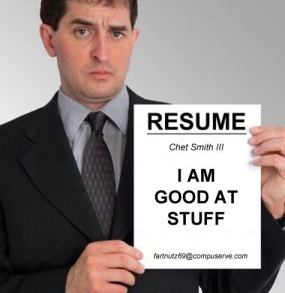
In earlier posts I talked about some fairly basic points to keep in mind when applying for editing work, and I offered some advice on how to position yourself on a resumé as an editor. Today, I’d like to talk about some typical errors people make concerning the language and content in their resumés. These are pervasive issues that don’t just apply to editors, but as language experts, editors should avoid them.
Adjective overkill
Hardworking, energetic, motivated, highly skilled, detail oriented, proficient, passionate, professional, outgoing, personable… . These are on the laundry list of adjectives peppering most resumés. It’s a problem because these adjectives tell, not show. By this I mean everyone can say these things about themselves, and they may very well be true, but you need to provide the evidence to back it up. That’s where the show part comes in. Admittedly, this is easier said than done, especially in our field. How do we show people the painstaking, quiet, veiled work we do? After all, our work is mostly invisible, and it’s hard to show anyone how many errors in logic, meaning, grammar, etc. we’ve eliminated or how transformative our work can be to a piece of text, whether it be on a billboard or in a thousand-page scholarly tome.
The first thing to do is to think in terms of verbs instead of adjectives. Use terms like clarified, parsed, organized, queried, resolved, distilled, researched, revised, improved, analyzed, evaluated, eliminated, negotiated, rewrote, reworded, communicated, recommended, flagged, corrected, fact-checked, managed… . You get the idea. Think long and hard about all the editing work that you’ve done. Chances are you’re overlooking a lot of the tasks, skills, and actions you perform while working. Verbs show what you’re able to do for the employer. Listing a bunch of presupposed qualities is not a good idea, that is, it goes without saying that you are hardworking and reliable; if you weren’t, chances are you wouldn’t be applying for the job—you’d be on your sofa, in your underwear, staring deeply into an empty bag of Cheetos.
To omit or not to omit
Equally important to what you put on a resumé is what you don’t put on it. The most obvious example of this is padding. Don’t do it. For example, if you don’t know Excel but are confident you could figure it out if you ever had to, you don’t know Excel. In fact, if you say you know Microsoft Word, be sure you do: resumé-reading software will check to see whether you’ve properly set up tabs or used the space bar. A reader with a trained eye will also be able to tell. Padding might get you the job, and maybe you’ll be able to muddle your way through it, but it can come back to bite you.
There is the opposite of padding: shortchanging yourself. Don’t discount experiences, jobs, projects, academic achievements, professional development, volunteer work, or any other meaningful accomplishments. Although I did say it was important to carefully tailor your resumé as an editor and focus on your editing-related work, we all have a diverse portfolio of offerings to bring to the table. The most important thing to do is focus on the value you bring to any undertaking. Provide evidence of your value whenever possible. A good way to do this is to get people who are happy with your work to put it in writing. Ask them to write a short letter or recommendation on LinkedIn. Developing and expanding your knowledge shows that you are invested in your work and want to increase the value of what you bring to it. Volunteer work shows that you are an active and giving member of society. Be sure that the volunteer work does not reflect any biased ethical, political, or religious position on your part, though.
About bias
In the same vein, do not reveal anything that might create a bias on the part of the resumé-reading robot or human. That includes giving away your age if you’re over a certain age, because without question there is ageism in the workplace. A few years ago I went to a talk and the speaker was an HR expert who was in the business for many years. He revealed things that made my hair stand on end. Resumé-reading software, the type that is used by most companies, will not consider applicants from certain “undesireable” postal codes. It deducts points for applicants with Hotmail addresses (versus Gmail) and applicants with “ethnic” names. It also deducts points if you’re over a certain age and don’t have a landline (considered a sign of instability). I am not joking. This HR person was very serious. When I asked what all this “equal opportunity” nonsense was about, he had no answer. I don’t know if this software has had its biases eradicated from it since then, but I have a feeling there are inherent biases in algorithms and humans alike. This is really too bad for anyone using this software or not doing their best to be fair, because they are losing out on an immense pool of creativity, experience, and knowledge.
Odds, ends, and in-betweens
Often, a cover letter is required. I hate this part. But while we still have to contend with this laborious requirement, we can at least bring it into the 21st century. Using Dear Sir or Madam or To Whom It May Concern as a greeting is very 20th century. Try and learn the hiring manager’s name. If you do find it, always use their full name in the greeting—for example, Dear John Smith—because you can’t always correctly guess the gender of the addressee by their name. Avoid fumbling with Mrs., Miss, and Ms.—talk about old-fashioned! These need to be retired. If you can’t find the full name of the hiring manager, Dear Hiring Manager will do. Even a Dear Company Name is OK. I also personally don’t mind a simple Hello—but never Hi, which is too informal.
Whatever you do, do not write about yourself in third person. This goes for your LinkedIn profile, too. Talking about yourself in third person is weird and off-putting, so why wouldn’t writing about yourself in third person have the same effect?
The order of a resumé should generally be profile (or summary), experience, and education, followed by these in any order: professional organizations, certifications, volunteer work, interests/hobbies (though it’s a judgement call about whether to include these; it can help break the ice at an interview—“Oh, you like medieval philosophy, too”—but it can also be viewed as extraneous information), and other peripheral headings.
Do include a profile instead of an objective line, though. Generally speaking, objective lines sound weak and forced, and immediately leave a bad impression. Don’t do it. Really talk up your achievements and abilities in your profile. Always remember: brevity is best. The resumé should not list every humdrum thing you’ve ever done. Edit the hell out of it. As an editor, it might be better to work your skills into your profile in a way that really makes them pop, instead of listing them somewhere. Don’t forget to mention style guides you are familiar with (e.g., Chicago Manual of Style, Canadian Press Stylebook) and specific programs (e.g., Grammarly, InCopy) that you know. References are available on request is passé. Do not write this. It’s tacitly understood that you have to provide references.
I hope I have given you some things to think about when it comes to the language and content you include—and don’t include—on your resumé. Keep it brief, active, first person, and focused. By brief I mean economize on space and verbiage while mentioning all the important points. Use up-to-date language. Do not include any information that can cause bias. Write it in your voice. Don’t try and write what you think other people want to hear or copy what other people have written. Authenticity goes a long way these days. In the last part of this series, I’d like to talk more about the structure of a resumé.
This article was copy edited by Afara Kimkeran.
The author of this article wishes to remain anonymous.
